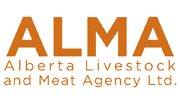Can byproduct pellets replace barley grain in diets for finishing cattle?
| Project Code: | FDE.17.13 |
| Completed: | 2014 |
Project Title:
Understanding the physiology behind changes in feed efficiency throughout the finishing period
Researchers:
Gregory Penner, PhD
Gregory Penner, PhD and John McKinnon, PhD (University of Saskatchewan), Louis Burciaga-Robles, PhD (Feedlot Health Management Services), Tim McAllister, PhD (AAFC-Lethbridge), Mary-Lou Swift, PhD (Alberta Agriculture), Matthew May, PhD (Feedlot Health Management Services)
- Canadian Journal of Animal Science, 93:523-528
Alberta’s feedlot industry is globally recognized as a leader for the production of high quality, healthy and safe beef used in both domestic and international markets. The growth of this industry has been based in part on a readily available supply of cereal grains. Specifically, price, supply and nutrient content have made barley the principle cereal grain for Alberta feedlots. Recently, this long-standing reliance on barley as the principle feed source has shown signs of change. It is well known that barley acres are shrinking in western Canada. As the grain industry continues to evolve towards the production of crops that create value-added opportunities, it is clear that Alberta’s feedlot sector will be challenged with maintaining profitability while faced with tightening supplies of barley grain and higher cereal grain prices.
One alternative to feed barley is strategically blended feed pellets based on by-products of industrial processing of western Canadian crops (i.e. dried distillers grains, pea and oat hulls, grain, pulse and canola screenings, off quality canola and feed peas). Blended feeds targeted at specific nutrient requirements will create a more efficient and competitive Alberta cattle industry, generate growth in the local feed industry as well as add value to the grain, pulse, oil seed, and bioenergy sectors through increased value and demand for by-products from crop processing. By more closely targeting specific nutrient requirements of cattle, these products can also reduce the nitrogen and phosphorus content of manure, thus reducing the potential negative impacts of large feedlots on the environment. However, the impacts of using high-lipid byproduct pellets as a feed for finishing cattle is not known.
Objectives:The objective was to develop and evaluate strategically formulated pellets for backgrounding and finishing cattle that optimize ruminal fermentation, growth performance, feed efficiency, and the net profit for cattle producers.
What They Did:A total of five studies were conducted within this project.
Study 1. The first study evaluated how the inclusion rate of a strategically formulated high-lipid byproduct pellet (HLP) affects dry matter intake, rumen fermentation, and nutrient digestibility when used as a partial replacement for barley grain and canola meal. Ruminally cannulated cattle were used for this study in a 4 x 4 Latin square design. Treatments included HLP included at 0, 30, 60, or 90% of the barley grain and canola meal. Rumen pH, short-chain fatty acids (byproducts arising from fermentation in the rumen and the main energy source for cattle), and ruminal and total tract digestibility were measured.
Study 2. Following the metabolism study, a growth performance study using 263 steers arranged into 12 pens (4 pens/treatment with 22 steers/pen) was conducted to evaluate the dry matter intake, growth performance and feed efficiency when the HLP were included at 0, 30, or 60% of the barley grain and canola meal. Body weight was measured at the start and end of the study and monthly throughout the study. Feed intake was measured throughout the study and gain:feed was calculated. Steers were slaughtered and carcass yield and quality grades were assessed.
Study 3. A longitudinal study was conducted using 8 ruminally cannulated cows to determine how diet and days on feed affected dry matter intake, growth performance, and nutrient utilization when fed a barley-based control diet or a diet where HLP replaced 60% of the barley grain and canola meal. Data and samples were collected every 40-d to evaluate dry matter intake, rumen pH, rumen short-chain fatty acid concentration and absorption, total tract digestibility, and post-absorptive utilization of glucose and acetate (two important nutrients used by muscle tissue and fat tissue).
Study 4. A growth performance study was conducted using 288 steers housed in 24 pens (12 steers/pen) and assigned to 1 of 4 treatments. Treatments included a combination of diet and timing for when the diet was fed; 1) steers were fed a barley-based control diet for the full finishing period (147 d), 2) steers fed a diet where HLP replaced 60% of the barley grain and canola meal and was fed for the full finishing period (147 d), 3) steers were fed the barley-based control diet for the first 49 d of the finishing period followed by the HLP diet for the last 98 d, or 4) steers fed the barley-based control diet for the first 98 d followed by feeding the HLP diet for the last 49 d of the finishing period. Performance for each 49-d feeding phase was evaluated including body weight, dry matter intake, average daily gain, and gain:feed. Steers were slaughtered and carcass yield and quality grades were assessed.
Study 5. A growth performance study was conducted using 288 steers housed in 24 pens (12 steers/pen) and assigned to 1 of 4 treatments. As with the study above, treatments included a combination of diet and the duration for which the diet was fed with a major difference being that the HLP were included at 30% of the barley grain and canola meal rather than 60% as for Study 4; 1) steers were fed a barley-based diet for the full 120-d finishing period, 2) steers were fed a diet where HLP replaced 30% of the barley grain and canola meal for the full 120-d finishing period, 3) steers were fed the barley-based control for 60 d followed by the HLP diet for 60 d, or 4) steers were fed the barley barley-based control for 60 d followed by the HLP diet with added canola oil for 60 d. The treatment with the added canola oil was used to determine whether providing additional energy in the form of oil could improve growth performance and carcass characteristics for finishing beef cattle. Performance of steers during each 60-d period was measured including dry matter intake, body weight, average daily gain, gain:feed, and carcass yield and quality grades.
What They Learned:Evaluating the inclusion rate of HLP (Studies 1 and 2)
Increasing the inclusion rate of HLP as a partial replacement for barley grain and canola meal did not affect dry matter intake but mean ruminal pH increased as the inclusion rate of HLP increased. That said, organic matter digestibility in the rumen and for total tract digestibility decreased in a dose-dependent manner with increasing HLP inclusion. In the growth performance study, steers fed HLP had greater dry matter intake but average daily gain did not differ from steers fed the barley-based control diet. Because of the greater dry matter intake and no change in growth, the G:F was less desirable for steers fed HLP. Carcass yield and quality were not affected.
Does timing of HLP feeding affect performance results (Studies 3, 4, and 5)?
Study 3 evaluated how feed intake, rumen fermentation, nutrient absorption, and post-absorptive nutrient utilization change with diet and days on feed. Cattle fed the HLP had lower dry matter intake, greater ruminal pH, but lower total tract digestibility than cattle fed the barley-based finishing diet supporting the studies above. Interestingly, total tract digestibility increased with days on feed. There were no difference among treatments for nutrient absorption and while nutrient absorption did not differ with days on feed, there was an increase in the liquid passage rate out of the rumen with advancing days on feed. Post-absorptive utilization of glucose and acetate did not differ by treatment or days on feed. Overall, this study confirmed that inclusion of HLP reduced total tract digestibility and that digestibility increases with advancing days on feed. While use of HLP may improve ruminal pH, SCFA absorption and arterial clearance of acetate and glucose were not affected.
Study 4 and 5 demonstrated that the high lipid byproduct pellets can be an effective alternative to barley grain and canola meal in conventional feedlot rations. However, reduced G:F, ADG, and hot carcass weights may occur when feeding the HLP throughout the finishing period. That said, the negative effects of feeding HLP can be reduced by reducing both the duration and by reducing the level of incorporation from 60 to 30% of the barley grain and canola meal.
What It Means:The studies within this project evaluated the use of high-lipid byproduct pellets (HLP) as a partial alternative to barley grain in diets for finishing cattle. At the time of the studies, HLP were priced at approximately $60/Mt less than rolled barley grain. This research demonstrated that the use HLP in diets for finishing cattle reduced G:F. Despite the reduction in G:F, lower feed costs were achieved with the use of HLP.
These studies also indicate that restricting the use of HLP to the latter part of the finishing period (last 49 or last 60 d) results in similar G:F relative to cattle fed a barley-based finishing diet. Overall, this research has demonstrated that HLP are a viable alternative to barley grain and, depending on feed prices, may be a strategy to reduce feed cost.












